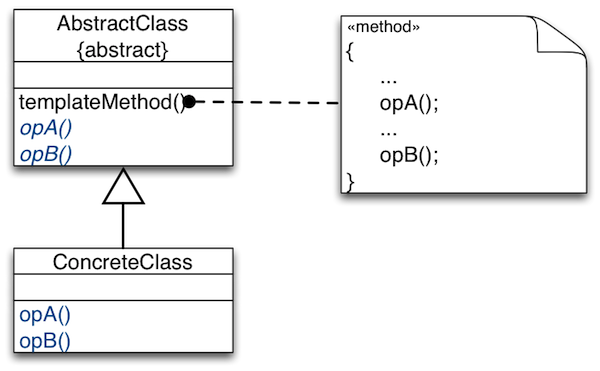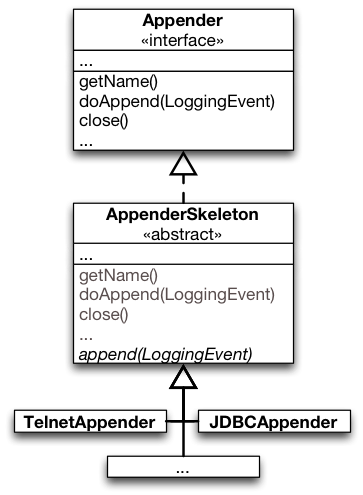Template-Method Design Pattern
The Template-Method Pattern in a Nutshell
Intent:
- Separate high-level policies from detailed low-level mechanisms.
- Separate invariant from variant parts.

Solution Idea:
Use abstract classes to:
- Define interfaces to detailed mechanisms and variant parts.
- Implement high-level policies and invariant parts to these interfaces.
- Control sub-class extensions.
- Avoid code duplication.
The Template-Method Pattern plays a key role in the design of object-oriented frameworks.
Example Application of Template Method
Functional requirements:
- Need a family of sorting algorithms …
(bubble sort, quick sort, etc.)
- for different kinds of data (int, double, etc.)
- Clients that use sorting algorithms should be reusable with a variety of specific algorithms.
Non-functional requirements on the design
Separating the Policy of Sorting

public abstract class BubbleSorter {
protected int length = 0;
Policy:
protected void sort() {
if (length <= 1) return;
for (int nextToLast = length - 2; nextToLast >= 0; nextToLast--)
for (int index = 0; index <= nextToLast; index++)
if (outOfOrder(index)) swap(index);
}
Mechanisms:
protected abstract void swap(int index);
protected abstract boolean outOfOrder(int index);
}
Implement the sorting policy in a template method, sort. Hide mechanisms needed for implementing the sorting policy behind abstract methods (outOfOrder and swap), which are called by the template method.
Filling the Template for Specific Algorithns

public class IntBubbleSorter
extends BubbleSorter {
private int[] array = null;
public void sort(int[] theArray) {
array = theArray;
length = array.length;
super.sort();
}
protected void swap(int index) {
int temp = array[index];
array[index] = array[index + 1];
array[index + 1] = temp;
}
protected boolean outOfOrder(int index) {
return (array[index] > array[index + 1]);
}
}
The advantages and deficiencies of the Template-Method Pattern are basically those of inheritance:
Template method forces mechanisms to extend a specific policy.
- Implementation of low-level mechanisms depends on the template.
- Cannot re-use low-level mechanisms functionality.
swap and outOfOrder implemented in IntBubbleSorter may be useful in other contexts as well, e.g., for quick sort.
Template Method Pattern in Log4J

interface Appender
Implement this interface for your own strategies for outputting log statements.
[…]
public void doAppend(LoggingEvent event)
Log in Appender specific way.
abstract class AppenderSkeleton implements Appender
Abstract superclass of the other appenders. This class provides the code for common functionality, such as support for threshold filtering and support for general filters.
[…]
protected abstract void append(LoggingEvent event)
Subclasses should implement this method to perform actual logging.
public void doAppend(LoggingEvent event)
This method performs threshold checks and invokes filters before delegating actual logging to the append(LoggingEvent) method.
Functional Counterpart of Template
One can look at the Template-Method Pattern as a style for emulating higher-order functions available in programming languages that support functional-style programming.
Alternative design for Log4J in Scala?
class AppenderSkeleton(
private val append : (LoggingEvent) => Unit
) {
def doAppend(loggingEvent : LoggingEvent) {
// filtering, threshold checks, …
append(loggingEvent)
}
}
Whether this is a feasible design or not requires a detailed analysis of the context; i.e., the AppenderSkeleton class. In this case, the method close indicates that an Appender may be in different states which suggests that the standard implementation approach is best suited (also in Scala).


